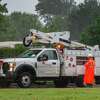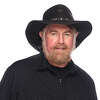
The glowing Horsetail Falls during a "firefall" event in Yosemite National Park in 2013.
Courtesy Lee DeCovnickThe Yosemite “firefall” is not a fire at all, but an ephemeral visual effect in the national park that appears on special evenings during a small window each winter.
The timing has to be perfect: It occurs when sunlight entering Yosemite Valley at dusk dips to just the right angle, refracting through the 1,575-foot Horsetail Fall and creating the effect of a burning flow of flame streaming into the granite valley.
It’s like witnessing a supernatural force, say Janice and Lee DeCovnick, who plan to take in the event next week for their 45th wedding anniversary. The two hobbyist photographers, who live in Walnut Creek, travel around the globe to shoot natural spectacles and have more than a quarter million images in their files.
“There’s this magical moment you’re waiting for and yet there’s always a question if it will happen,” said Janice DeCovnick. “When it does, you watch this absolutely spectacular display. You feel so blessed, exhilarated.”
The phenomenon often occurs in February, though exact timing is tough to predict more than a couple weeks out. Experts anticipate that, for 12 days, from Feb. 12 through Feb. 24, the confluence of moisture, air clarity and sunlight could provide a rare chance to see the firefall each evening for about 10 minutes.
The chance of seeing the firefall typically draws scores of tourists to the park. This year, getting to the site will require a little more planning.
To to manage visitor numbers amid COVID-19, Yosemite is requiring visitors to reserve day passes online in advance. A few hundred day-use permits are made available each day at 8 a.m., two days in advance, through the park’s reservation service at www.Recreation.gov. They are expected to sell out in minutes, said Scott Gediman, the park’s assistant superintendent for public and legislative affairs.
Horsetail Fall drains a small watershed and requires fresh precipitation to keep it flowing. With rain and snow forecast for late Thursday and again Saturday in Yosemite, followed by clear weather, the prospects of the firefall event at Horsetail Fall is more likely to arrive the week of Feb. 15.
But it's fickle. Last year, for instance, dry weather prevented the firefall from occurring.
“You need the water, the light and no clouds,” said Lee DeCovnick.

A view of Horsetail Falls in Yosemite National Park during an anticipated firefall event that didn't occur.
Courtesy Lee DeCovnickThe DeCovnicks have photographed Yosemite each year for the past decade and taken more than 20 targeted trips to capture the spectacle.
“In all of those visits, we’ve only seen the phenomenon in its full glory twice, and another four or five times with good color,” he said. “The moment when it lights up, actually refracting, all of a sudden, it just sorts of pops, glowing, lava-like, deep colors with vibrancy, gorgeous.”
Ten years ago, about 500 people showed up in hopes of photographing the event. The spectacular stories and photos from that year led to worldwide attention. Five years ago, about 2,000 photographers packed into the key viewing site, near the El Capitan Picnic Area, according to the Park Service.
Last year, to minimize crowding, the park began closing parking in the vicinity, requiring photographers to hike 1.5 miles to reach the viewing area.
Here's how to best position yourself to capture the perfect photo of the spectacle.
Getting to the spot
Your best chance to photograph the Yosemite Firefall phenomenon requires a full day of preparation.
Drive to the formal parking lot for Yosemite Falls, across from Yosemite Valley Lodge, by 1 p.m. or so. Then hike the 1.5 miles to the El Capitan Picnic Area and set up your viewing site. The park has closed other parking areas closer to the viewing site; stopping to drop off passengers at these areas is not allowed.
“Show up pretty early in the afternoon to get a decent spot to set up,” said Janice DeCovnick. As the photographers gather, it becomes a festive atmosphere amid the anticipation, she said.
The El Capitan Picnic Area is more of a reference point of where to best see the phenomenon, rather than a specific destination. It is located just off Northside Drive and provides a view of Horsetail Fall looking west, out towards the entrance of Yosemite Valley.
The best spot to position your camera is not directly head-on, in front of Horsetail Falls, the DeCovnicks said, but rather about 90 yards to the east. From an angle, you have the best chance to see more of the deep reds at peak color.
“From the front, it’s really golden, a rosy golden,” Janice said. “From the right, with an angle on it, you get more reds because of the refraction angle of the light through the water,” Lee added.

The "firefall" event in Yosemite National Park in 2013.
Courtesy Lee DeCovnickGetting the perfect shot
Many photographers who chase the event carry multiple cameras and are constantly adjusting their settings and framings as the light changes. The DeCovnicks, for instance, usually carry five cameras and two tripods between them.
You don't have to be a professional to capture a nice photo for your personal collection. The key is not gear, they said, but rather timing; you need to be there when the event hits flashpoint.
But if you want the best picture you can get, the DeCovnicks have some tips:
Set your camera: ISO at 200 to 320; f-Stop at f-18; shutter speed between 500th-of-a-second to a-fifth-of-a-second, Janice said. “The camera, the lens, the light — there are so many factors."
Lee then added: “Bracket, bracket, bracket! The light changes very quickly.” He means, you’ll have to change your settings quickly to compensate for the changing light.
However, the DeCovnicks advise viewers to take moments between shots to enjoy the moment.
“Some people get camera-fixated, and then, all of a sudden it’s over, and they missed it,” Lee said. “They have to go home and see their photos to see what they missed. Instead, take some time off just to sit there and look, enjoy it, whoop and holler a little."
Tom Stienstra is a contributing outdoors writer. Email: tomstienstra2021@gmail.com. Twitter: @StienstraTom.
























